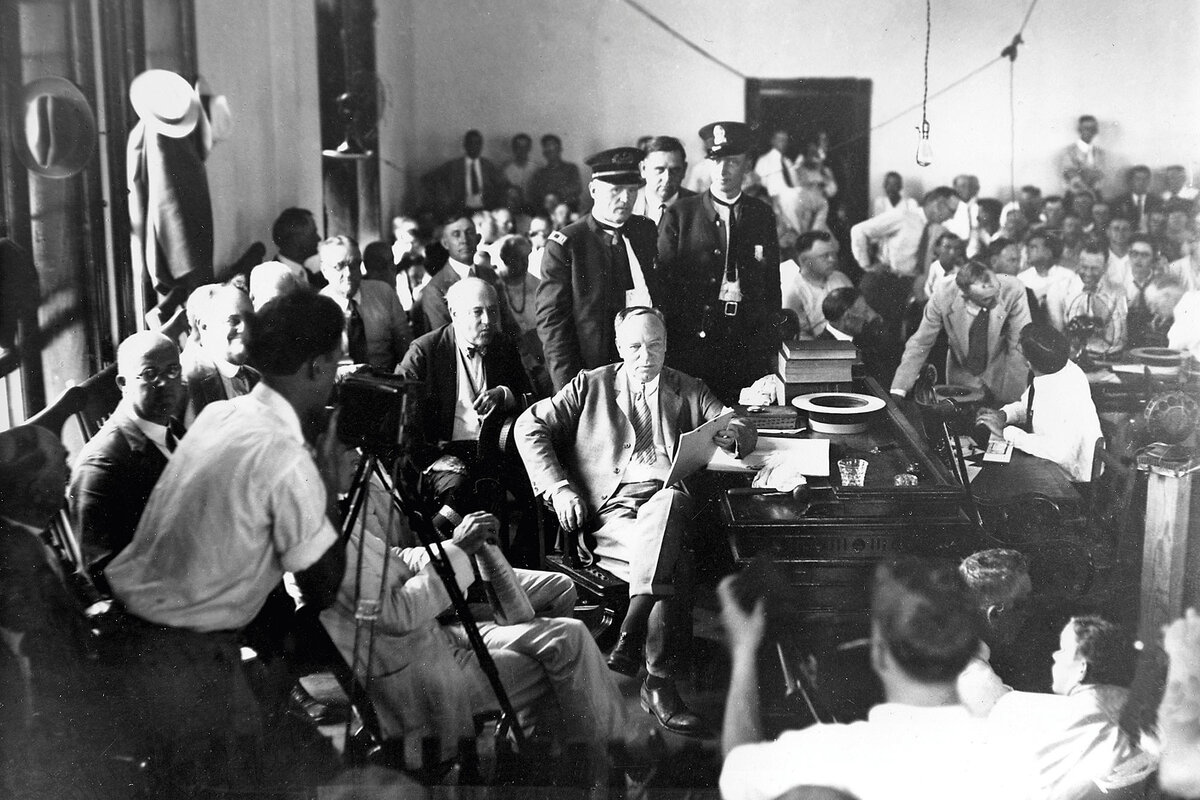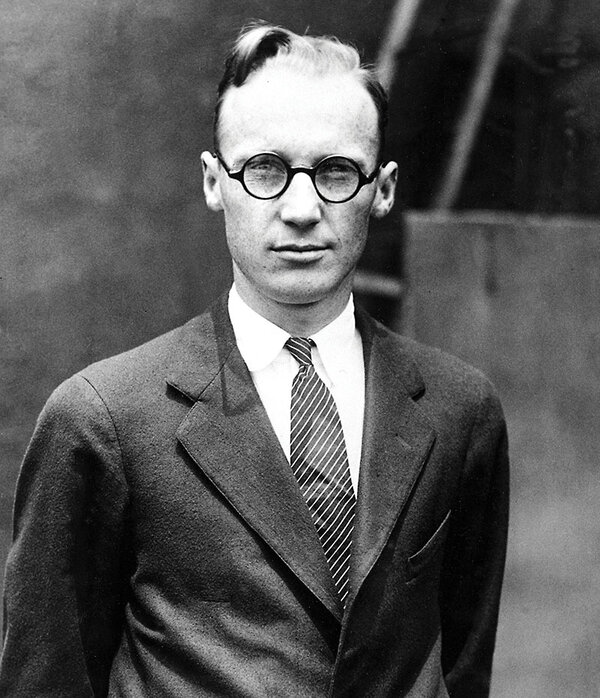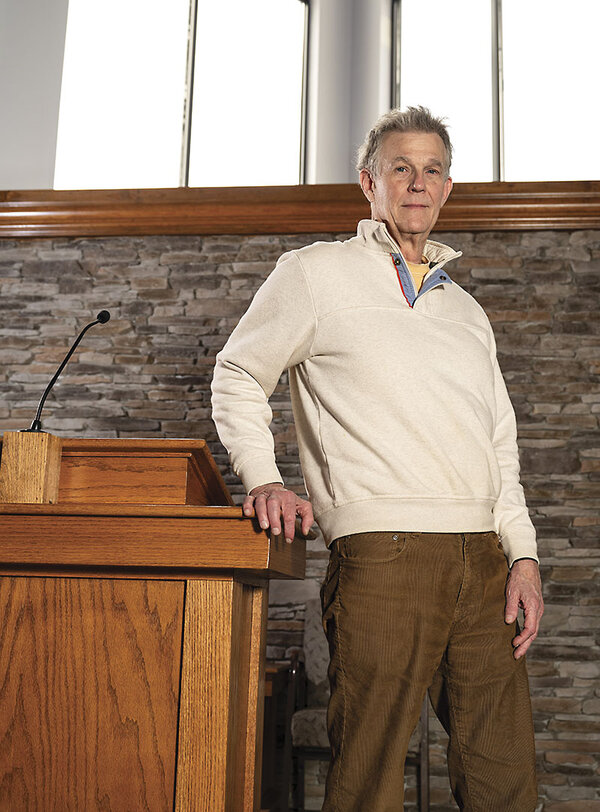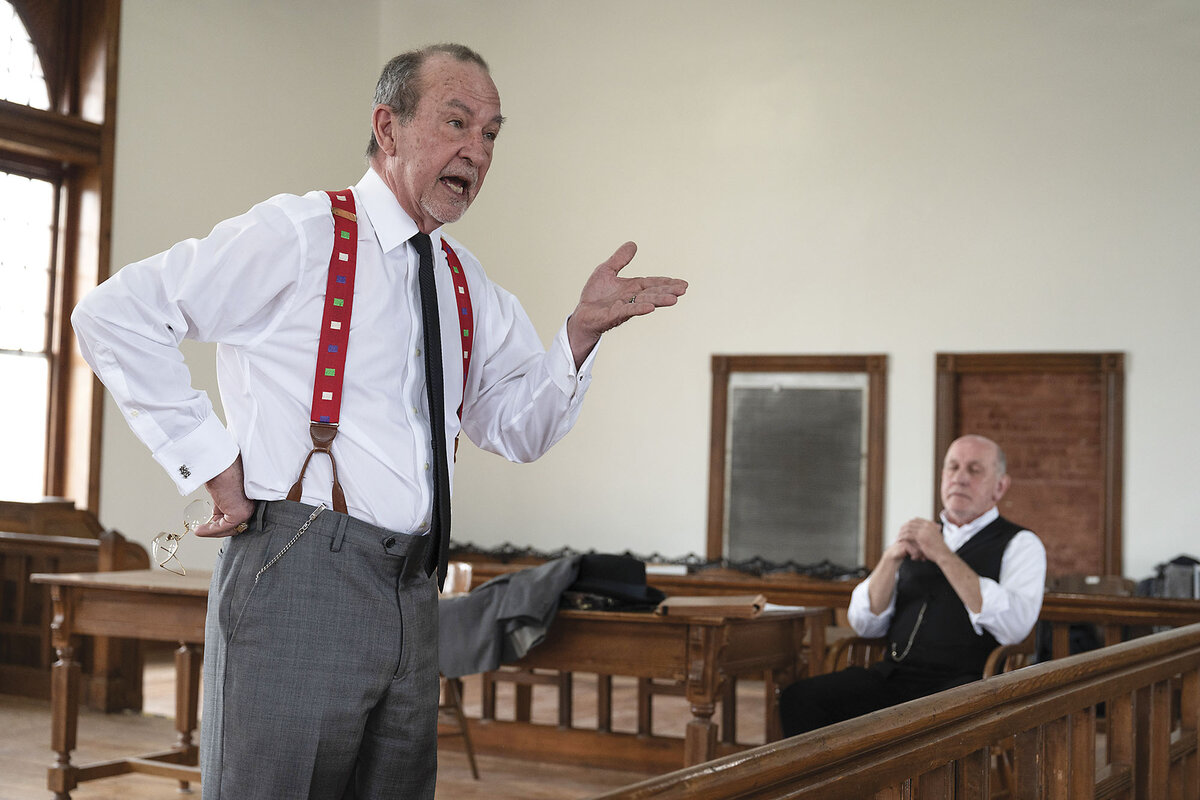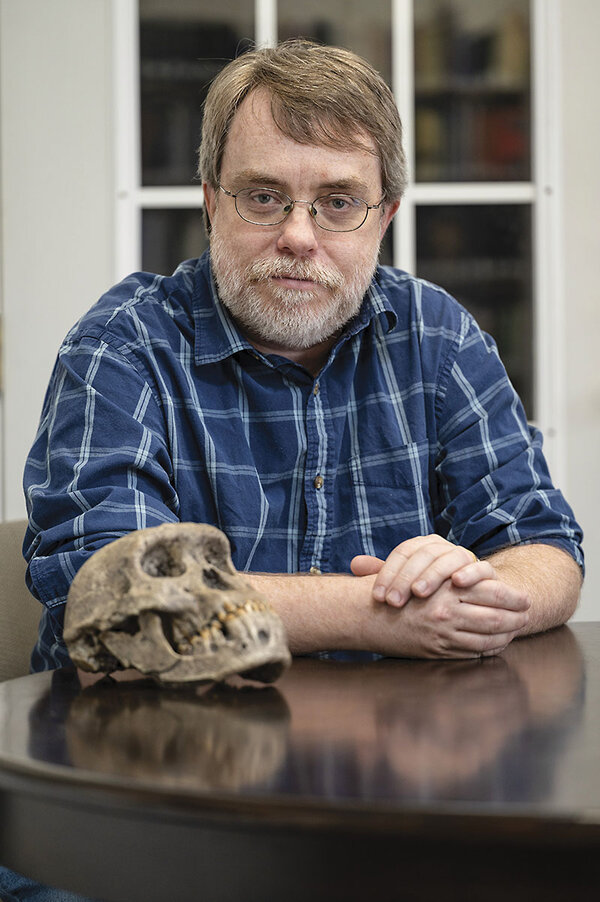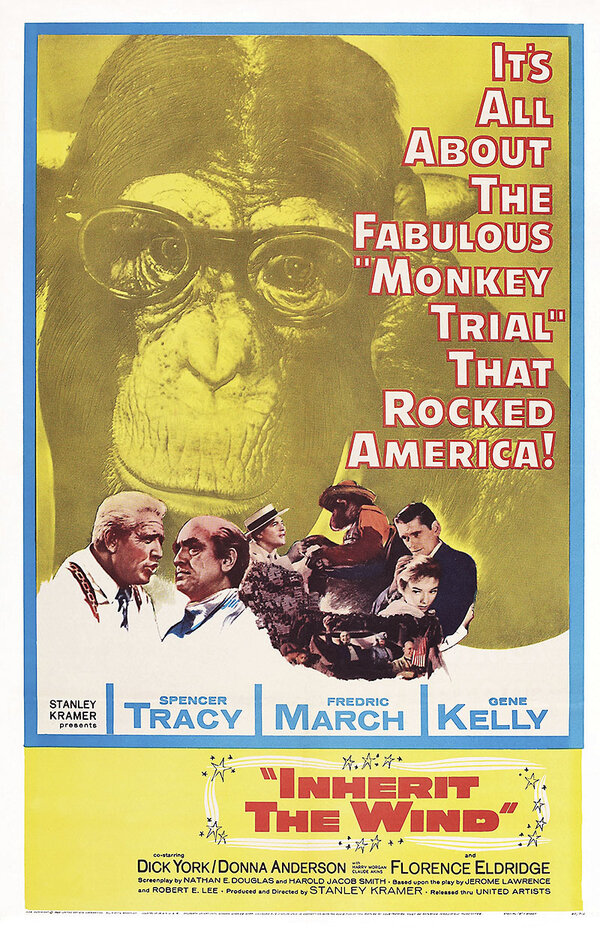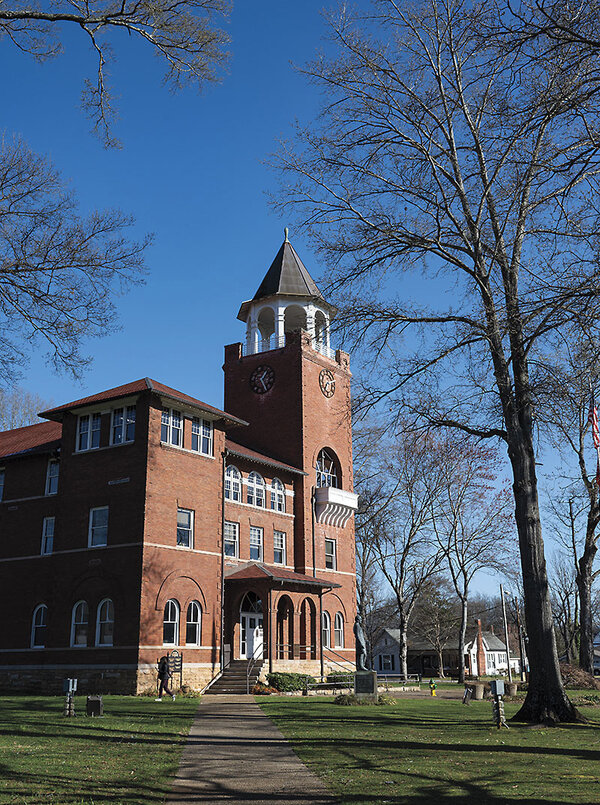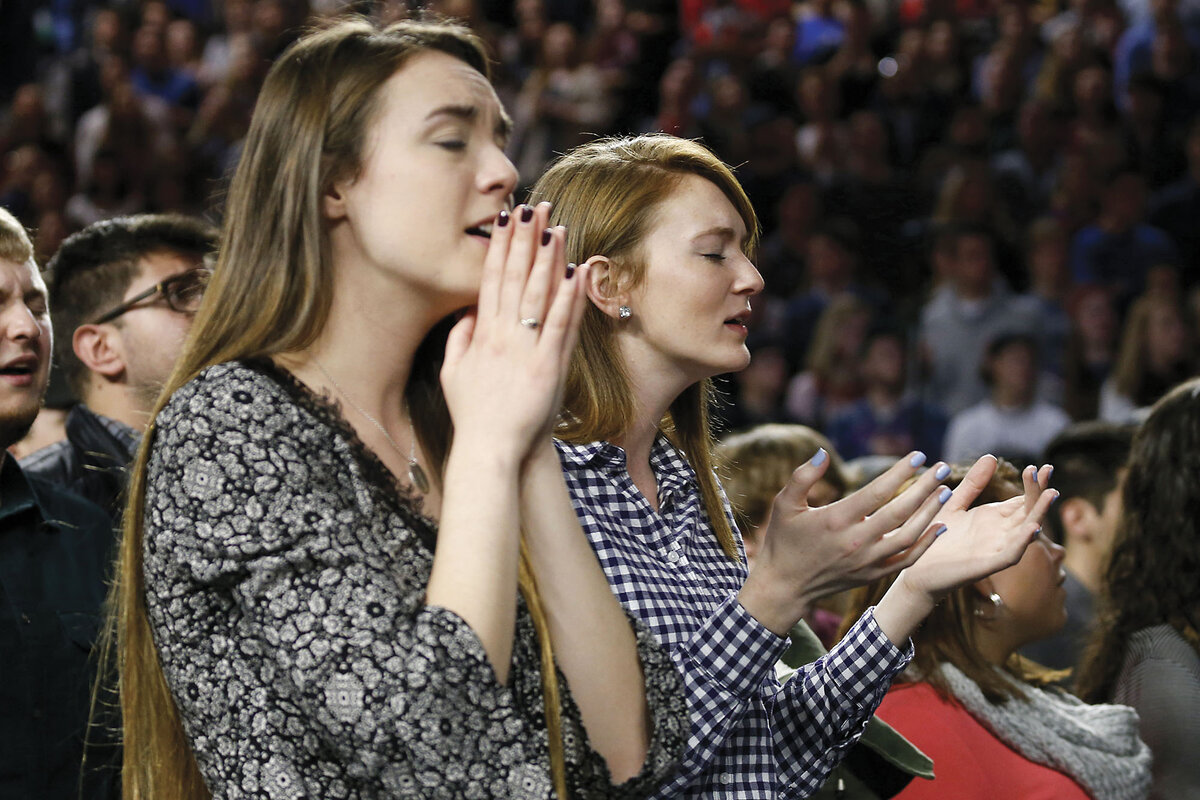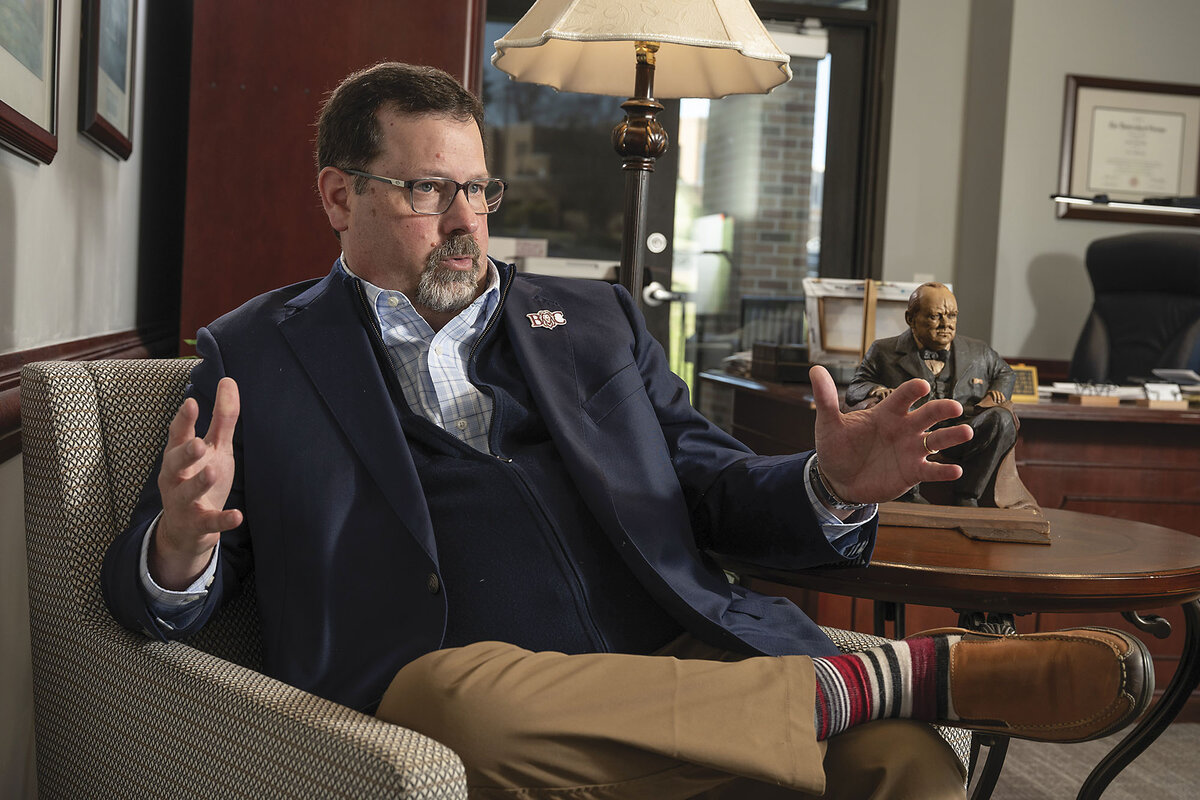Remembering Scopes: How 100-year-old ‚ÄòMonkey Trial‚Äô helped shape evangelical ∫£Ω«¥Û…Òity
Loading...
| Dayton, Tenn.
It began with a newspaper ad and ended with a trial of historic proportions.
Nearly overnight, the State of Tennessee v. John Thomas Scopes – dubbed the “Monkey Trial” by journalist H.L. Mencken – laid claim to being America’s first “trial of the century.”
The criminal trial lasted less than a week in a hot Dayton, Tennessee, courtroom in July 1925. One hundred years later, it still reverberates as the opening salvo of a wider cultural conflict that continues to impact, if not define, the relationship between religion and politics in the United States.
Why We Wrote This
The first ‚Äútrial of the century‚Äù galvanized a brand of evangelical ∫£Ω«¥Û…Òity that has reached new heights of political influence today. We trace the arc of that journey, from retreat to engagement.
In March of that year, the state of Tennessee passed a bill banning the teaching of evolution in any public school or university. Conservative Protestants, who’d recently adopted the label “fundamentalists,” had the political clout to make the issue a priority. Charles Darwin’s theory, most believed, was both a contradiction of the literal account of creation laid out in the book of Genesis and a threat to faith and morality.
Two months later, on May 4, 1925, the 5-year-old American Civil Liberties Union placed an ad in the Chattanooga Daily Times offering to finance a “test case” that would challenge the constitutionality of the new Tennessee law. The organization believed it violated the separation of church and state by making the Bible the standard of truth in a public institution.
Business leaders in Dayton, a small town of 1,800 residents, saw an opportunity to get publicity. So they convinced a local football coach and science teacher, John Scopes, to take up the nascent civil rights organization’s offer. Scopes was hesitant, and he wasn’t even sure he’d ever taught evolution. But he agreed to stand in as a tide of religious and cultural forces converged on the town.
Across the country, there had been a growing religious chasm between “modernists,” who sought to adjust modern faith with the findings of science, and “fundamentalists,” who believed in the literal, not interpreted, word of the Bible. That conviction extended to matters of the natural world.
The issues were not simply about scientific facts. For most fundamentalists, a “biblical worldview” included nonnegotiables, such as God creating humanity as male and female in the image of God. This included the ordaining of procreation, marriage, and the nuclear family – in other words, the core purposes of human life, in their view. The idea that human beings somehow evolved from “monkeys” was an affront to divine reality and human dignity, as fundamentalists understood it.
The publicity-stunt-turned-trial also featured two of the most famous lawyers in the country: William Jennings Bryan, a firebrand populist and fundamentalist who had been the Democratic Party’s nominee for president three times; and Clarence Darrow, one of the most well-known trial lawyers in the country and a self-proclaimed religious skeptic and agnostic. The stage was set.
Over 100 reporters descended on Dayton. The town had to build a new telegraph office as well as an airstrip to accommodate the media demand. It was the first trial to be broadcast live on radio across the country.
After six days, the jury made its verdict known: Scopes, accused of teaching evolution during a biology class, was found guilty and fined $100, or about $1,700 today. Bryan had raised the banner for fundamentalists, and won a legal victory for their ideas.
In the minds of an attentive public nationwide, however, Darrow and the young defendant won the cultural and scientific debate decisively – despite the ruling of the court in Tennessee.
It was a moment when many realized how profoundly the nation‚Äôs religious landscape had changed. Established institutions of American higher education, such as Harvard, Yale, and others, many of which had been founded to train men for ∫£Ω«¥Û…Ò ministry, had fully embraced modernism.
The teaching of evolution remains an issue in some jurisdictions around the country. Even if it has not been at the forefront of the nation’s culture wars, the clash at the Scopes Trial has been on full display in issues such as school choice and parental rights, human sexuality and gender, and the notion of the separation of church and state. Understanding the trial, its roots, and its cultural impact helps put today’s conflicts in context.
“We’re always wrestling with what roles religion should play in public life,” says Matthew Sutton, professor of history at Washington State University. “The Scopes Trial is one of those touchpoint moments where we’re asking this question again, and we’re trying to wrestle with it.”
The governing bodies of most major Protestant denominations accepted Darwin’s ideas, and their interpretations of Scripture began to evolve. After the trial, the rift in American Protestantism between modernists and fundamentalists continued to widen. Religious conservatives began to break away to form their own denominations – as well as their own seminaries and private schools, from elementary to high school to college.
Much of the media coverage of the trial mocked traditionalist religious views – as well as the rural areas where many fundamentalists lived. The term “fundamentalist” began to be a smear. In many ways, the religious victors of the Scopes Trial mostly retreated from public life.
“There was a definite pulling out of and away from society” by fundamentalists in response to the mocking tone of public opinion, says Carter Johnson, pastor of Westminster Presbyterian Church in Dayton.
The withdrawal would last for decades. But over that period, the fundamentalist movement would rebrand as “evangelical.” And the religiously conservative subculture would start to flourish, rooting itself in significant parts of the national culture – parts the news media often glossed over or ignored. At the same time, mainline and more liberal Protestant denominations would begin to decline.
By the 1980s, evangelical Protestants would reemerge as major voices within the nation’s religious landscape – and a potent political force that helped propel Ronald Reagan to two terms as U.S. president. Since then, Evangelicals have become important power players in the Republican Party and, particularly, in the second administration of President Donald Trump.
Reenacting Dayton’s “Monkey Trial”
In the same Dayton courtroom where the Scopes Trial took place 100 years ago, a man wearing red suspenders and a black tie strides to the defense table. He surveys the room, chest puffed out.
It is Clarence Darrow, played by Rick Dye. Opposite him, Tony McCuiston sits at the prosecutor’s table playing William Jennings Bryan, wearing a white shirt and black vest with a pocket watch, and with a bowler hat resting on the table.
The pair stand silent, frozen in time, as two other people approach the bench. It’s a four-person play, and, flashing forward, a grandfather tells the story of the trial to his grandson as they look on from the future.
“A fundamentalist,” the grandfather explains, “is someone who believes in the biblical story of creation.”
The stage turns back to Bryan and Darrow, who lob lines at each other, reenacting an exchange from the trial.
‚ÄúThese gentlemen have no other purpose than to ridicule every ∫£Ω«¥Û…Ò who believes in the Bible!‚Äù Bryan says of the defense. ‚ÄúWe have the purpose of preventing bigots and ignoramuses from controlling the education of the United States!‚Äù Darrow fires back.
Dayton leaders are once again gearing up for a lot of attention at the 100th anniversary of the Scopes Trial. The play, sponsored by the Rhea Heritage Preservation Foundation, is just one of the commemorative events Rhea County is planning.
And this annual reenactment isn’t the only reminder of the trial. Down the street is the Monkey Town Brewing Co., and in the other direction is Jennings Coffee & Tea. A mile or two away is Bryan College, chartered in 1930 and committed to “remaining true to biblical principles.”
But that embrace of history was slow. Embarrassed by the media portrayal of the trial, Dayton smothered talk of the trial for decades, and Mr. Dye and others who graduated from high school there in the 1970s and 1980s didn’t learn about it until years later.
Dayton was a dry town until 1997, locals say, and for that reason some didn’t expect the brewery to last when it opened – especially given its name. A decade later, it’s one of the most popular spots in town. The owner’s grandparents not only attended the trial in 1925, but had their first date there.
Today, Dayton’s population is about 7,300. It’s the kind of place where families proudly remember generations of family history – and many are descendants of participants in the trial. A few even play their ancestor in one of the reenactments.
In Dayton, ideas about evolution and creation still conflict
The churches in Dayton are mainly Baptist, Presbyterian, and Pentecostal. The closest synagogues and mosques are in Chattanooga. It’s a town with more churches than restaurants, and as a description of the local culture, people frequently quote: “If the South is the Bible Belt, Dayton is certainly the buckle.”
Many people in Dayton are creationists. Bryan College has a Center of Creation Research, and biochemist Todd Charles Wood, who taught at the college for years, founded the Core Academy of Science, a nonprofit that “nurtures the next generation of faithful, Christ-like creation researchers to explore the hardest problems in creation.”
On the anniversary of the Tennessee law criminalizing the teaching of evolution, Bryan College held a banquet kicking off the summerlong commemoration of the trial. The college hosted historian Edward Larson, author of a Pulitzer Prize-winning book about the Scopes Trial, as the keynote speaker. After Mr. Larson, a local pastor spoke in defense of the biblical worldview expressed at the trial.
“When Bryan agreed to talk about those things, there was something deeper than just what may or may not have happened in the classroom of John Scopes,” said Jim Woychuk, senior pastor of Grace Bible Church in Dayton.
Bryan saw “that if you are a believer in the Gospel of Jesus and you love his word, you should still take your stand [against] the view that human beings are mere accidents, that there really is no meaning.” Belief in human evolution, Mr. Woychuck warned, “has consequences.”
Stung by media caricatures and stereotypes
Residents of Dayton were stung by the cultural caricatures exacerbated by sensationalist coverage of the trial – and then again by the 1960 film “Inherit the Wind.”
A fictionalized dramatization of the Scopes Trial, the film was a parable attacking McCarthyism and the Red Scare tactics of the time. And it caricatured the people of Dayton – and fundamentalists more broadly – as close-minded and unsophisticated.
Directed by Stanley Kramer, “Inherit the Wind” starred-box office sensations Spencer Tracy and Gene Kelly and garnered critical acclaim.
When the town gathered to watch a screening of “Inherit the Wind” in 1960, spirits were high. But people in Dayton were shocked by the way the town was portrayed. Today, many Dayton residents say the movie did more damage than the trial.
“The story [of the trial] is even more amazing” than this fictionalized account, says Mr. Dye, president of the preservation foundation, who has acted in various roles in the play since 1993. Their play does not disparage creationist views. Still, the vast majority of tourists who attend the play “think they’re going to see ‘Inherit the Wind,’” he says.
But the hostility of the film toward fundamentalism isn‚Äôt the only story about the legacy of the Scopes Trial, says Dr. Wood, who describes himself as a creation scientist. Another, he says, is the story of people, committed conservative ∫£Ω«¥Û…Òs, fascinated by the science that challenges their faith.
“For me, before it is anything else, creation is a doctrine of the faith,” says Dr. Wood, who has a doctorate in biochemistry from the University of Virginia. Sitting in his Dayton office, he gestures to shelves of hundreds of cataloged books, mainly science or biblical studies. “I spend as much time studying religion as science.”
Across the country, over a third of Americans say God created humans in the last 10,000 years, according to a 2024 Gallup poll. Another third say humans did evolve over time, but with God’s guidance. A smaller share, 24%, accept the scientific theory of evolution without the involvement of a higher power.
In 1968, the U.S. Supreme Court struck down an Arkansas statute that banned the teaching of evolution – a landmark ruling that declared such laws a violation of the First Amendment’s establishment clause, as Darrow had argued in 1925.
“This is about inclusive public education. It was back then, and it is today,” says Rachel Laser, president and CEO at Americans United for Separation of Church and State.
There’s a “raging, two-pronged attack” on public education around the country, she says, referencing laws mandating the Ten Commandments be displayed in classrooms and an effort to publicly fund a religious charter school in Oklahoma.
Though the controversy surrounding evolution doesn’t attract major attention today, it hasn’t completely dissipated. In 2004, plaintiffs in Dover, Pennsylvania, challenged the school district’s requirement that “intelligent design,” which proponents say is a version of creationism that does not appeal to religion or biblical teaching, be taught alongside evolution. A judge, appointed by then-President George W. Bush, ruled intelligent design was also religious doctrine, and not science.
Religious conservatives with creationist views, however, have continued trying to carve out space in public schools to include their views of creation in science classes.
In 2008, Louisiana passed a controversial bill that allowed teachers to present materials critical of evolution and global warming. In 2012, Tennessee passed its own law opening the door to the teaching of creation theories alongside evolution. And last year, West Virginia passed legislation permitting for public school teachers to teach creationism in science classes.
Among Mr. Johnson’s congregants, some are “young Earthers,” most of whom believe the Earth and humanity were created by God between 6,000 and 10,000 years ago. Others believe in a different time frame for creation. But all believe God was the creator of a historic Adam and Eve, he says.
“It’s possible for us to live in a worldly, secular society but maintain our faith,” Mr. Johnson says. He sees truth in aspects of evolution, but doesn’t believe humans evolved from what he regards as a lower life-form.
“I think Scopes should be seen as the opening of a long debate over evolution,” says Alexander Gouzoules, a law professor at the University of Missouri. Mr. Gouzoules and his father, Harold Gouzoules, an evolutionary biologist, published a book this year about the significance of the trial.
“Before Scopes, you really don’t see many examples of religion’s place in society being decided through litigation,” he says. “Today we live in a world where that’s just routine.”
Fundamentalists reemerge as politically powerful Evangelicals
In many ways, the fundamentalist movement that withdrew from that of American cultural elites after the Scopes Trial began to reemerge in the 1950s, especially behind the popular evangelist Billy Graham.
Taking advantage of radio and television media, Mr. Graham brought a more middle-class, professional, and media-savvy sensibility to this American subgroup. Many broke away, too, from the fundamentalist label, taking on the identifier “Evangelical.”
On the one hand, the trial “accelerated fundamentalists’ political maturation, in that they realized how they could be co-opted in some ways – and also that they could exercise their power in other ways,” says Dr. Sutton at Washington State University. “It helped them think about, if they’re going to try to influence American society, American life, that they need to do it in a methodical, sophisticated, intelligent kind of way.
“That is why fundamentalists had to rebrand, because so much of the leading media was so cynical about who they were and what they were trying to do – that they really were misrepresented, and had very little ability to correct that,” he says.
In 1942, the National Association of Evangelicals formed, opening offices in Washington, D.C. And as evangelists like Mr. Graham became more popular spreading an appealing patriotic religious message, evangelicalism began to flourish around the country.
Evangelicals were always political, but they weren’t partisan, Dr. Sutton says. That changed with the Civil Rights Movement, when many white Evangelicals resisted the integration of public schools. Religious conservatives in Southern states, previously an unchallenged Democratic stronghold that revered William Jennings Bryan, gradually realigned with the Republican Party.
Conservative operatives within the Republican Party worked to mobilize evangelical leaders like Jerry Falwell, who built the Moral Majority as a political coalition focusing at first on parental rights, education, and race. Later, this organization helped galvanize religious opposition to abortion and gay rights as it emphasized traditional marriage and family structures.
As a group, white Evangelicals reemerged as a potent political force after they backed Mr. Reagan en masse, helping him win the presidency in 1980. They would go on to become one of the largest and most loyal constituencies of the Republican Party over the next half-century. The Evangelicals of today, Dr. Sutton says, “have their roots” in that 1940s renewal prompted by the effects of the Scopes Trial.
Despite decline, more powerful than ever
White evangelical Protestants have declined over the past two decades, surveys show, and today the group makes up about 13% of the U.S. population, according to a 2023 survey by the Public Religion Research Institute.
Still, the issues they care about most feature prominently in national debates. In many ways, 100 years after Scopes, evangelical political power has reached its zenith in the second administration of Mr. Trump.
President Trump appointed three of the nine Supreme Court justices in his first term, and each of the six-member supermajority on the court is considered a devout religious conservative. Since John Roberts became chief justice in 2005, the court’s interest in hearing religious liberty cases has only grown. A religious coalition of Evangelicals and conservative Catholics have seen victory after victory at the high court, including overturning Roe v. Wade and allowing public funds for religious institutions.
President Trump this year has also created a task force to ‚ÄúEradicate Anti-∫£Ω«¥Û…Ò Bias,‚Äù saying the executive order was intended to ‚Äúend the anti-∫£Ω«¥Û…Ò weaponization of government.‚Äù
‚ÄúAppeal to Heaven‚Äù flags ‚Äì first a symbol of the American Revolution but more recently adopted by ∫£Ω«¥Û…Ò nationalist groups ‚Äì have flown outside a home owned by Supreme Court Justice Samuel Alito and the Capitol offices of now-Speaker of the House Mike Johnson and other Republican lawmakers. Secretary of Defense Pete Hegseth led a prayer service at the Pentagon during which it was suggested that President Trump is divinely appointed. The idea has circulated since at least 2016, but it gained momentum at last summer‚Äôs Republican National Convention, just after Mr. Trump narrowly survived an assassination attempt at a rally in Butler, Pennsylvania.
“The polling shows us that Evangelicals are losing their numbers in terms of the percentage of the population,” says Dr. Sutton. “Yet they are more powerful than ever in terms of influencing the courts and public policy.”
Dayton has the same desire to grow today as it had in the 1920s, says Douglas Mann, president of Bryan College. And when students graduate, they often take their biblical worldview into their workplaces and civic lives.
“We’re going to engage,” he says. “We’re not going to retreat from society.”
Today, Dr. Mann sees many of the same issues playing out in similar ways to a century ago, especially at the intersection of science and religion and how Evangelicals who hold creationist and other traditionalist views about family life respond to criticism.
A “good view of education” is to know your own position, he says, but your opponent’s better.
Although Bryan College has a student body of about 1,600, it is well-connected. Sen. Marsha Blackburn, now one of the most powerful people in Tennessee state politics, and fellow Tennessee Sen. Bill Hagerty sent representatives to a banquet at Bryan College on the March 21 centennial of the passage of the Butler Act, the law that criminalized the teaching of evolution.
‚ÄúWe saw that in his life, [Bryan] was deeply committed to seeing the moral development of young people, the character development of young people that was based in, for him, the foundation of that education, God‚Äôs word, Dr. Mann says. ‚ÄúAnd Bryan held tenaciously to, in ∫£Ω«¥Û…Ò circles what is called ‚Äòinerrancy,‚Äô that God‚Äôs word is true, infallible ‚Äì and in our college affirms those same things.‚Äù
Down the road from Bryan College, the characters of Bryan and Darrow are alive in the old courthouse. The courtroom is on the second floor, a room with tall windows and soaring ceilings. A wide staircase leads down to the doors outside, next to which hangs a plaque displaying the Ten Commandments. Further into the building, in the basement, is a museum displaying artifacts from the trial.
And in front of the courthouse are two statues opposite each other: Darrow and Bryan. At night, a single spotlight shines on Bryan. Darrow stands in the dark.
Editor’s note: This article was updated to correct Sen. Marsha Blackburn’s ties to Bryan College. She is a graduate of Mississippi State University.



